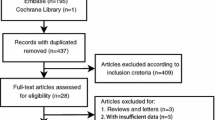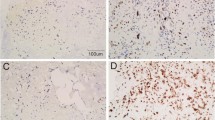Abstract
Hypoxia-inducible factor (HIF)-1α is a transcription factor that supports the adaptation of human cancer cells to hypoxia and tumor growth and progression. The overexpression of HIF-1α protein has been reported to be associated with a worse prognosis in various cancers. However, the expression of HIF-1α in soft-tissue sarcomas has not yet been characterized. The expression of HIF-1α protein was immunohistochemically determined in 49 specimens of soft-tissue sarcomas including malignant fibrous histiocytoma (29 patients), synovial sarcoma (12 patients), leiomyosarcoma (four patients), and malignant peripheral nerve sheath tumors (four patients). The 49 samples consisted of 40 primary lesions and nine local recurrences. An immunohistochemical analysis showed the nuclear accumulation of HIF-1α protein in 35 (71.4%) samples. The expression of HIF-1α was negative in 14 (28.6%) cases, weak in nine (18.4%), moderate in 17 (35.4%), and strong in nine (18.4%). The patients with a strong or moderate expression of HIF-1α had a significantly shorter overall survival rate in comparison with those with a weak or negative expression in a univariate analysis (P = 0.029; log-rank test) and multivariate analysis (P = 0.018). This is the first report that demonstrated an overexpression of HIF-1α protein to be an independent prognostic factor for soft-tissue sarcomas.



Similar content being viewed by others
References
Aebersold DM, Burri P, Beer KT, Laissue J, Djonov V, Greiner RH, Semenza GL (2001) Expression of hypoxia-inducible factor-1α: a novel predictive and prognostic parameter in the radiotherapy of oropharyngeal cancer. Cancer Res 61:2911–2916
Birner P, Schindl M, Obermair A, Plank C, Breitenecker G, Oberhuber G (2000) Overexpression of hypoxia-inducible factor 1α is a marker for unfavorable prognosis in early-stage invasive cervical cancer. Cancer Res 60:4693–4696
Birner P, Gatterbauer B, Oberhuber G, Schindl M, Rossler K, Prodinger A, Budka H, Hainfellner JA (2001) Expression of hypoxia-inducible factor-1α in oligodendrogliomas: its impact on prognosis and on neoangiogenesis. Cancer 92:165–171
Bos R, Zhong H, Hanrahan CF, Mommers EC, Semenza GL, Pinedo HM, Abeloff MD, Simons JW, van der Wall E (2001) Levels of hypoxia-inducible factor-1α during breast carcinogenesis. J Natl Cancer Inst 93:309–314
Brizel DM, Scully SP, Harrelson JM, Layfield LJ, Bean JM, Prosnitz LR, Dewhirst MW (1996) Tumor oxygenation predicts for the likelihood of distant metastasis in human soft tissue sarcoma. Cancer Res 56:941–943
Carmeliet P, Dor Y, Herbert JM, Fukumura D, Brusselmans K, Dewerchin M, Neeman M, Bono F, Abramovitch R, Maxwell P, Koch C, Ratcliffe P, Moons L, Jain RK, colleen D, Keshert E (1998) Role of HIF-1α in hypoxia-mediated apoptosis, cell proliferation, and tumor angiogenesis. Nature 394:485–490
Chao C, Al-Saleem T, Brooks JJ, Rogatko A, Kraybill WG, Eisenberg B (2001) Vascular endothelial growth factor and soft tissue sarcomas: tumor expression correlates with grade. Ann Surg Oncol 8:260–267
Chen C, Pore N, Behrooz A, Ismail-Beigi F, Maity A (2001) Regulation of glut1 mRNA by hypoxia-inducible factor-1. Interaction between H-ras and hypoxia. J Biol Chem 276:9519–9525
Cordon-Cardo C, Latres E, Drobnjak M, Oliva MR, Pollack D, Woodruff JM, Marechal V, Chen J, Brennan MF, Levine AJ (1994) Molecular abnormalities of mdm2 and p53 genes in adult soft tissue sarcomas. Cancer Res 54:794–799
Dan’ura T, Kawai A, Morimoto Y, Naito N, Toshida A, Inoue H (2002) Apoptosis and expression of its regulatory proteins in soft tissue sarcomas. Cancer Lett 178:167–174
Dobashi Y, Noguchi T, Nasuno S, Katayama K, Kameya T (2001) CDK-inhibitor-associated kinase activity: a possible determinant of malignant potential in smooth muscle tumors of the external soft tissue. Int J Cancer 94:353–362
Feldser D, Again F, Iyer NV, Pak B, Ferreira G, Semenza GL (1999) Reciprocal positive regulation of hypoxia-inducible factor 1α and insulin-like growth factor 2. Cancer Res 59:3915–3918
Fillies T, Werkmeister R, van Diest PJ, Brandt B, Joos U, Buerger H (2005) HIF1-alpha overexpression indicates a good prognosis in early stage squamous cell carcinomas of the oral floor. BMC Cancer 5:84
Fletcher CDM, Unni KK, Mertens FE (2002). Pathology and genetics of tumours of soft tissue and bone. In: Fletcher CDM, Unni KK, Mertens FE (eds) World Health Organization classification of tumours. IARC, Lyon
Forsythe JA, Jiang BH, Iyer NV, Agani F, Leung SW, Koos RD, Semenza GL (1996) Activation of vascular endothelial growth factor gene transcription by hypoxia-inducible factor 1. Mol Cell Biol 16:4604–4613
Fyles A, Milosevic M, Headley M, Pintilie M, Levin W, Manchul L, Hill RP (2002) Tumor hypoxia has independent predictor impact only in patients with node-negative cervix cancer. J Clin Oncol 20:680–687
Gerdes J, Lemke H, Baisch H, Wacker HH, Schwab U, Stein H (1984) Cell-cycle analysis of a cell proliferation-associated human nuclear antigen defined by the monoclonal antibody Ki-67. J Immunol 133:1710–1715
Graeven U, Andre N, Achilles E, Zornig C, Schmiegel W (1999) Serum levels of vascular endothelial growth factor and basic fibroblast growth factor in patients with soft-tissue sarcoma. J Cancer Res Clin Oncol 125:577–581
Greene FL, Page DL, Fleming ID et al (eds) (2002) AJCC cancer staging manual, 6th edn. Springer, Berlin Heidelberg New York
Guillou L, Coindre JM, Bonichon F, Nguyen BB, Terrier P, Collin F, Vilain MO, Mandard AM, Le Doussal V, Leroux A, Jacquemier J, Duplay H, Sastre-Garau X and Costa J (1997) Comparative study of the National Cancer Institute and French Federation of Cancer Centers Sarcoma Group grading systems in a population of 410 adult patients with soft tissue sarcoma. J Clin Oncol 15:350–362
Harris AL (2002) Hypoxia: a key regulatory factor in tumor growth. Nat Rev Cancer 2:38–47
Heslin MJ, Cordon-Cardo C, Lewis JJ, Woodruff JM, Brennan MF (1998) Ki-67 detected by MIB-1 predicts distant metastasis and tumor mortality in primary, high grade extremity soft tissue sarcoma. Cancer 83:490–497
Hockel M, Schlenger K, Aral B, Mitze M, Schaffer U, Vaupel P (1996) Association between tumor hypoxia and malignant progression in advanced cancer of the uterine cervix. Cancer Res 56:4509–4515
Hoos A, Stojadinovic A, Mastorides S, Urist MJ, Polsky D, Di Como CJ, Brennan MF, Cordon-Cardo C (2001) High Ki-67 proliferative index predicts disease specific survival in patients with high-risk soft tissue sarcomas. Cancer 92:869–874
Jemal A, Tiwari RC, Murray T, Ghafoor A, Samuels A, Ward E, Feuer EJ, Thun MJ (2004) Cancer statistics, 2004. CA Cancer J Clin 54:8–29
Jiang BH, Agani F, Passaniti A, Semenza GL (1997) V-SRC induces expression hypoxia-inducibe factor 1 (HIF-1) and transcription of encoding vascular endothelial growth factor and enolase 1: involvement of HIF-1 in tumor progression. Cancer Res 57:5328–5335
Jiang BH, Jiang G, Zheng JZ, Lu Z, Hunter T, Vogt PK (2001) Phosphatidylinositol 3-kinase signaling controls levels of hypoxia-inducible factor 1. Cell Growth Differ 12:363–369
Kawauchi S, Goto Y, Liu XP, Furuya T, Oga A, Oda Y, Tsuneyoshi M, Ihara K, Sasaki K (2001) Low expression of p27(Kip1), a cyclin-independent kinase inhibitor, is a marker of poor prognosis in synovial sarcoma. Cancer 91:1005–1012
Koukourakis MI, Giatromanolaki A, Sivridis E, Simopoulos C, Turley H, Talks K, Gatter KC, Harris AL (2002) Hypoxia-inducible factor (HIF1A and HIF2A), angiogenesis, and chemoradiotherapy outcome of squamous cell head-and-neck cancer. Int J Radiat Oncol Biol Phys 53:1192–1202
Kuwai T, Kitadai Y, Tanaka S, Onogawa S, Matsutani N, Kaio E, Ito M, Chayama K (2003) Expression of hypoxia-inducible factor-1α is associated with tumor vascularization in human colorectal carcinoma. Int J Cancer 105:176–181
Lidgren A, Hedberg Y, Grankvist K, Rasmuson T, Vasko J, Ljungberg B (2005) The expression of hypoxia-inducible factor 1α is a favorable independent prognostic factor in renal cell carcinoma. Clin Cancer Res 11:1129–1135
Maseide K, Kandel RA, Bell RS, Catton CN, O’Sullivan B, Wunder JS, Pintilie M, Hedley D, Hill RP (2004) Carbonic anhydrase IX as a marker for poor prognosis in soft tissue sarcoma. Clin Cancer Res 10:4464–4471
Molina P, Pellin A, Navarro S, Boix J, Carda C, Llombart-Bosch A (1997) Analysis of p53 and mdm2 proteins in malignant fibrous histiocytoma in absence of gene alteration: prognostic significance. Virchows Arch 435:596–605
Nakanishi H, Ohsawa M, Naka N, Uchida A, Ochi T, Aozasa K (1997) Immunohistochemical detection of bcl-2 and p53 proteins and apoptosis in soft tissue sarcoma: their correlations with prognosis. Oncology 54:238–244
Nordsmark M, Hoyer M, Keller J, Nielsen OS, Jensen OM, Overgaard J (1996) The relationship between tumor oxygenation and cell proliferation in human soft tissue sarcomas. Int J Radiat Oncol Biol Phys 35:701–708
Nordsmark M, Overgaard M, Overgaard J (1996) Pretreatment oxygenation predicts radiation response in advanced squamous cell carcinoma of the head and neck. Radiother Oncol 41:31–39
Richard DE, Berra E, Gothie E, Roux D, Pouyssegur J (1999) p42/p44 mitogen-activated protein kinases phosphorylate hypoxia-inducible factor 1α (HIF-1α) and enhance the transcriptional activity of HIF-1. J Biol Chem 274:32631–32637
Saenz NC, Heslin MJ, Adsay V, Lewis JJ, Leung DH, LaQuaglia MP, Brennan MF (1998) Neovascularity and clinical outcome in high-grade extremity soft tissue sarcomas. Ann Surg Oncol 5:48–53
Schindl M, Schoppmann SF, Samonigg H, Hausmaninger H, Kwasny W, Grant M, Jakesz R, Kubista E, Birner P, Oberhuber G (2002) Overexpression of hypoxia-inducible factor 1α is associated with an unfavorable prognosis in lymph node-positive breast cancer. Clin Cancer Res 8:1831–1837
Semenza GL, Wang GL (1992) A nuclear factor induced by hypoxia via de novo protein synthesis binds to the human erythropoietin gene enhancer at a site required for transcriptional activation. Mol Cell Biol 12:5447–5454
Semenza GL (2000) Hypoxia, clonal selection, and the role of HIF-1 in tumor progression. Crit Rev Biochem Mol Biol 35:71–103
Semenza GL (2003) Targeting HIF-1 for cancer therapy. Nat Rev Cancer 3:721–732
Sivridis E, Giatromanolaki A, Gatter KC, Harris AL, Koukourakis MI, Tumor and Angiogenesis Research Group (2002) Association of hypoxia-inducible factors 1α and 2α with activated angiogenic pathways and prognosis in patients with endometrial carcinoma. Cancer 95:1055–1063
Tomlinson J, Barsky SH, Nelson S, Singer S, Pezeshki B, Lee MC, Eilber F, Nguyen M (1999) Different patterns of angiogenesis in sarcomas and carcinomas. Clin Cancer Res 5:3516–3522
Vleugel MM, Greiler AE, Shvarts A, van der Groep P, van Berkel M, Aarbodem Y, van Tinteren H, Harris AL, van Diest PJ, van der Wall E (2005) Differential prognostic impact of hypoxia induced and diffuse HIF-1α expression in invasion breast cancer. J Clin Pathol 58:172–177
Volm M, Koomagi R (2000) Hypoxia-inducible factor (HIF-1) and its relationship to apoptosis and proliferation in lung cancer. Anticancer Res 20:1527–1533
Wang GL, Jiang BH, Rue EA, Semenza GL (1995) Hypoxia-inducible factor 1 is a basic-helix-loop-helix-PAS heterodimer regulated by cellular O2 tension. Proc Natl Acad Sci USA 92:5510–5514
West CC, Brown NJ, Mangham DC, Grimer RJ, Reed MWR (2005) Microvessel density dose not predict outcome high grade soft tissue sarcoma. Eur J Surg Oncol 31:1198–1205
Wykoff CC, Beasley NJ, Watson PH, Turner KJ, Pastorek J, Sibtain A, Wilson GD, Turley H, Talks KL, Maxwell PH, PughCW, Ratcliffe PJ, Harris AL (2000) Hypoxia-inducible expression of tumor-associated carbonic anhydrases. Cancer Res 60:7075–7083
Zhong H, De Marzo AM, Laughner E, Lim M, Hilton D, Zagzag D, Buechler P, Isaacs WB, Semenza GL, Simons JW (1999) Overexpression of hypoxia-inducible factor 1α in common human cancers and their metastases. Cancer Res 59:5830–5835
Zundel W, Schindler C, Haas-Kogan D, Koong A, Kaper F, Chen E, Gottschalk AR, Ryan HE, Johnson RS, Jefferson AB, Stokoe D, Giaccia AJ (2000) Loss of PTEN facilitates HIF-1-mediated gene expression. Genes Dev 14:391–396
Acknowledgement
We thank the secretarial staff of the Department of Orthopedic Surgery, Mie University School of Medicine, for their generous cooperation.
Author information
Authors and Affiliations
Corresponding author
Rights and permissions
About this article
Cite this article
Shintani, K., Matsumine, A., Kusuzaki, K. et al. Expression of hypoxia-inducible factor (HIF)-1α as a biomarker of outcome in soft-tissue sarcomas. Virchows Arch 449, 673–681 (2006). https://doi.org/10.1007/s00428-006-0304-4
Received:
Revised:
Accepted:
Published:
Issue Date:
DOI: https://doi.org/10.1007/s00428-006-0304-4




